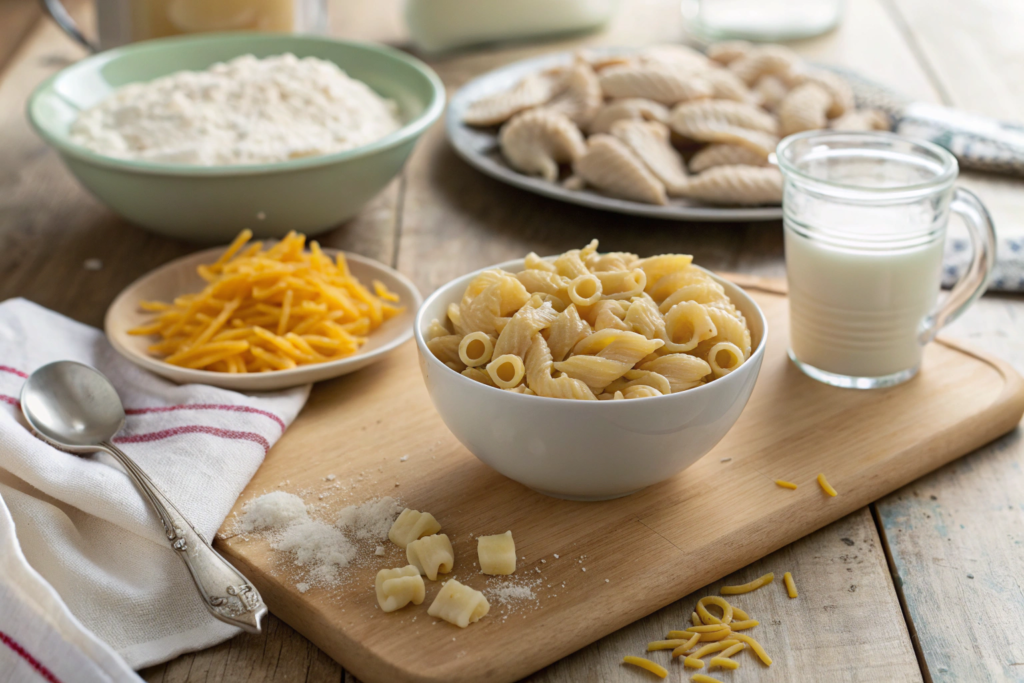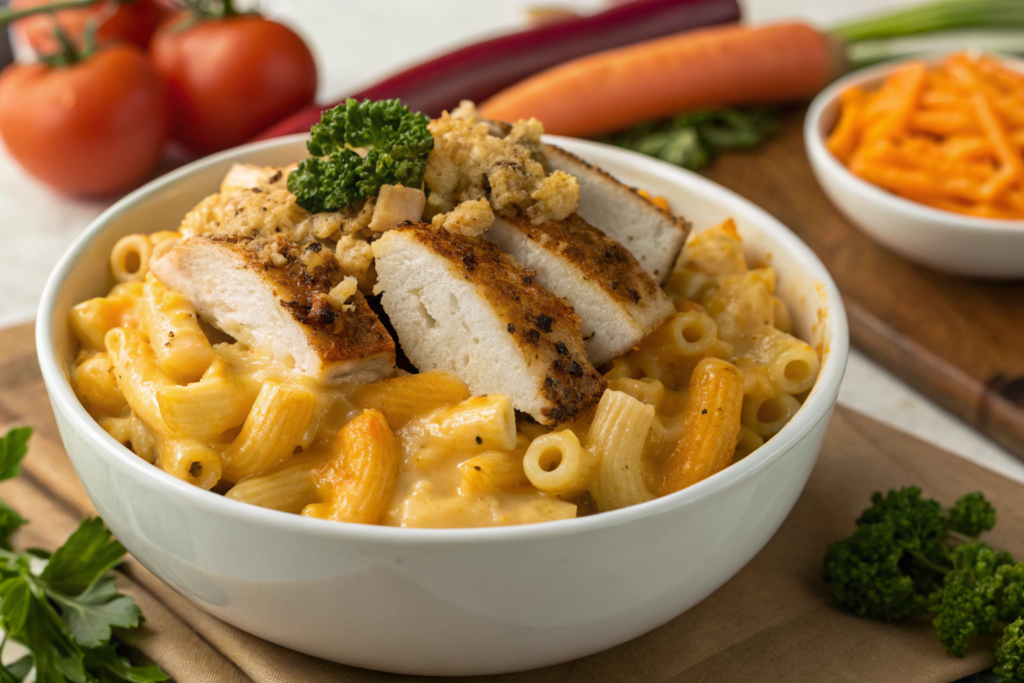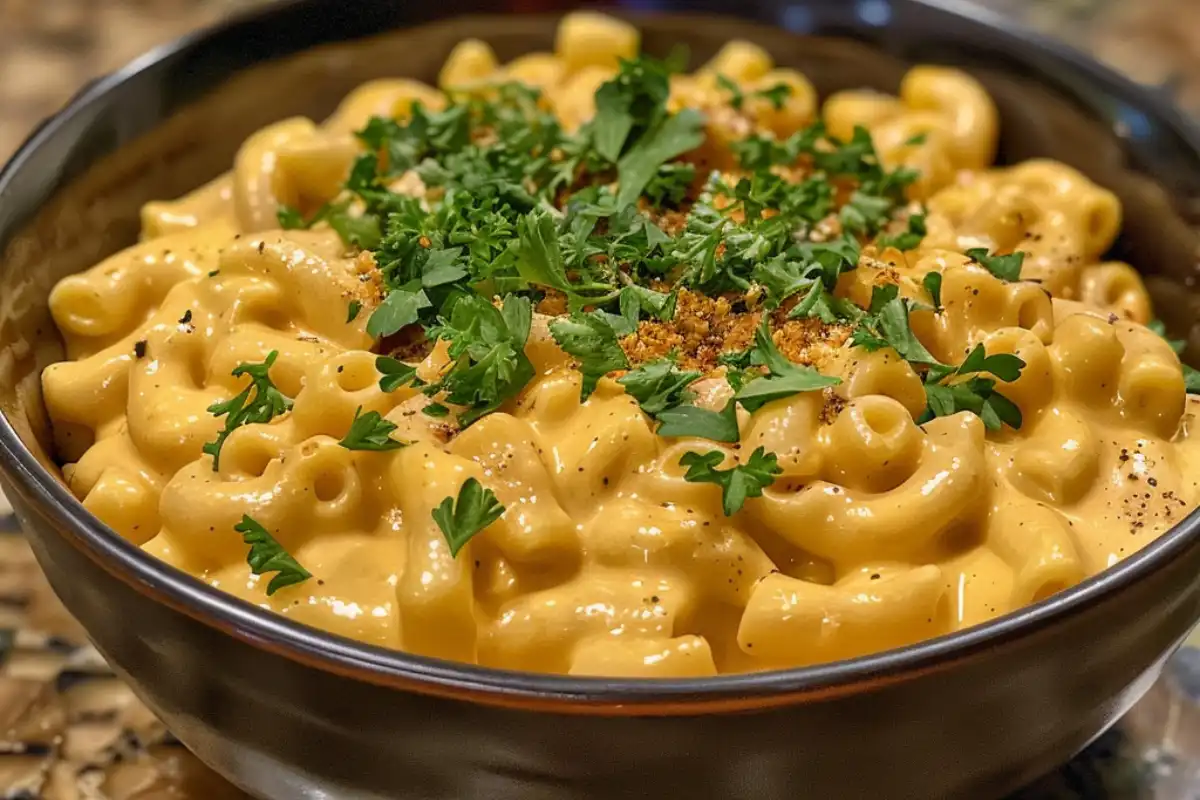If you’re a fan of mac and cheese but looking to boost your protein intake, protein mac and cheese is the perfect solution. This beloved comfort food can easily be transformed into a more balanced and nutritious dish with just a few ingredient swaps. Whether you’re trying to gain muscle, lose weight, or simply eat a bit healthier, adding extra protein to your meals can be a game-changer.
This comprehensive guide will walk you through every detail of making delicious protein mac and cheese, including variations, ingredients, step-by-step instructions, and expert tips for customization. Let’s dive in!
Table of Contents
Why Choose Protein Mac and Cheese?
Mac and cheese is the epitome of comfort food—creamy, cheesy, and delicious. However, traditional mac and cheese can be lacking in protein. Protein mac and cheese maintains all the indulgence while incorporating more protein-rich ingredients.
Benefits of Protein Mac and Cheese
- Increased Satiety: Protein helps keep you full longer, making your meal more satisfying.
- Versatility: You can easily adapt the recipe by using various protein sources like chickpea pasta, cottage cheese, or chicken.
- Meal Prep Friendly: It stores well in the fridge and freezer, making it a convenient meal prep option.
- Fitness Goals: Ideal for muscle building, weight management, and maintaining balanced nutrition.
Protein mac and cheese isn’t just for athletes; it’s perfect for anyone who enjoys creamy, cheesy comfort food while maintaining a nutritious diet.
Essential Ingredients for Protein Mac and Cheese

1. High-Protein Pasta
Instead of traditional pasta, opt for a high-protein alternative such as:
- Chickpea pasta – Gluten-free and high in protein.
- Lentil pasta – Earthy flavor and protein-rich.
- Whole wheat or protein-enriched pasta – More protein than regular pasta.
2. Protein-Rich Cheese
Cheese is a key ingredient, and some varieties pack more protein:
- Cottage cheese – High in protein and adds a creamy texture.
- Cheddar cheese – Classic flavor and good protein content.
- Parmesan cheese – Adds umami depth and extra protein.
3. Additional Protein Sources
Enhance protein content with these additions:
- Cooked chicken or turkey – Lean protein that blends well.
- Tofu or tempeh – Great for plant-based versions.
- Greek yogurt – Adds creaminess and protein.
- Eggs – Stir in a beaten egg for richness and extra protein.
4. Milk or Dairy Alternatives
- Fairlife milk – Higher protein than regular milk.
- Almond, soy, or oat milk – Dairy-free options with protein benefits.
You can learn more about whether cottage cheese browns in the oven.
Step-by-Step Recipe Guide
Ingredients (Serves 4):
- 2 cups high-protein pasta (chickpea or lentil pasta)
- 1 cup cottage cheese
- 1/2 cup shredded cheddar cheese
- 1/4 cup milk (or dairy-free alternative)
- 1 tablespoon cornstarch (for thickening)
- Salt and pepper to taste
- Optional: Cooked chicken or ground turkey for extra protein
Instructions:
- Cook the Pasta: Boil a large pot of salted water and cook pasta according to package instructions. Drain and set aside.
- Blend the Cheese Sauce: In a blender, combine cottage cheese, shredded cheddar, milk, and cornstarch. Blend until smooth and creamy.
- Thicken the Sauce: Pour the cheese mixture into a skillet over medium heat. Stir continuously for 4-5 minutes until the sauce thickens.
- Mix with Pasta: Add cooked pasta to the sauce and stir to coat evenly. Season with salt and pepper to taste.
- Add Protein (Optional): Stir in cooked chicken, turkey, or tofu for an extra protein boost.
- Serve and Enjoy: Garnish with extra cheese or parmesan and serve hot.
Pro Tip: If you prefer baked mac and cheese, transfer to an oven-safe dish, top with breadcrumbs, and bake at 350°F for 10-15 minutes.
Popular Variations of Protein Mac and Cheese

1. Vegan Protein Mac and Cheese
- Use plant-based pasta like chickpea or lentil pasta.
- Blend cashews, nutritional yeast, and almond milk for a creamy cheese sauce.
- Add tofu, tempeh, or seitan for extra protein.
2. Baked Protein Mac and Cheese
- Mix pasta with cheese sauce and transfer to a baking dish.
- Top with breadcrumbs and extra cheese.
- Bake at 350°F for 15 minutes until golden and crispy.
3. Spicy Protein Mac and Cheese
- Add chili flakes, paprika, or jalapeños for heat.
- Drizzle with hot sauce or mix in diced spicy sausage.
4. Chicken Protein Mac and Cheese
- Stir in grilled or shredded chicken for a filling meal.
- Add spinach or broccoli for extra nutrients.
here’s a guide on how to cook chicken for recipes to get the best texture and flavor
Customization Tips
1. Protein Variations
- Meat lovers: Ground beef, turkey, or sausage.
- Vegetarian: Tofu, tempeh, or edamame.
- Eggs: Stir in a beaten egg for richness and protein.
2. Vegetable Additions
- Broccoli, spinach, or zucchini – Nutrient-rich and delicious.
- Cauliflower – Boiled or roasted for texture and nutrients.
- Peas – Simple and easy to mix in.
3. Flavor Enhancements
- Garlic powder, onion powder, or mustard – For depth of flavor.
- Smoked paprika or red pepper flakes – For heat.
- Pesto – Adds a fresh and unique twist.
For more inspiration, you can explore this guide on what to serve with mac and cheese.
Storage, Reheating, and Meal Prep Tips
Storing Leftovers
- Fridge: Store in an airtight container for up to 4 days.
- Freezer: Freeze for up to 3 months in portioned containers.
Reheating Tips
- Oven: Bake at 325°F for 10-15 minutes.
- Microwave: Heat in 30-second intervals, stirring in between.
Meal Prep Tip
- Keep pasta and sauce separate for best texture.
- Portion into individual containers for easy grab-and-go meals.
Protein mac and cheese is the ultimate comfort food with a nutritious twist. It’s versatile, easy to make, and can be customized to fit any diet. Whether you’re looking for a post-workout meal, a family-friendly dinner, or a meal prep option, this dish is a perfect choice.
Experiment with different ingredients, flavors, and toppings to create your perfect version. Enjoy every creamy, cheesy, protein-packed bite!
Frequently Asked Questions (FAQs)
1. Can I Use Regular Pasta Instead of High-Protein Pasta?
- Yes, but high-protein pasta increases the protein content significantly.
2. What’s the Best Cheese for Protein Mac and Cheese?
- Cottage cheese and cheddar are excellent for a protein-rich and creamy dish.
3. How Can I Make a Vegan Version?
- Use nutritional yeast, cashew cream, and plant-based milk for the cheese sauce.
4. How Long Does Protein Mac and Cheese Last?
- It lasts 4 days in the fridge and up to 3 months in the freezer.
5. Can I Add Vegetables?
- Absolutely! Broccoli, cauliflower, and spinach pair well with the creamy texture.
Protein Mac and Cheese
This Protein Mac and Cheese is a creamy, cheesy, and satisfying dish with extra protein to keep you full and energized! Made with protein-packed pasta, Greek yogurt, and lean cheese, it’s the perfect healthy twist on a comfort food classic. 🧀💪
- Prep Time: 10 minutes
- Cook Time: 15 minutes
- Total Time: 25 minutes
- Category: Dinner
- Method: Stovetop
Ingredients
For the Protein Mac and Cheese:
- 8 oz high-protein pasta (chickpea, lentil, or whole wheat)
- 1 tbsp unsalted butter
- 1 clove garlic, minced
- 1 ½ cups skim or low-fat milk
- ½ cup Greek yogurt or cottage cheese (blended smooth)
- 1 cup shredded cheddar cheese (or a mix of cheddar & Parmesan)
- ¼ cup grated Parmesan cheese
- 1 scoop unflavored whey protein powder (optional)
- ½ tsp salt
- ½ tsp black pepper
- ¼ tsp smoked paprika (optional)
For Toppings (Optional):
- Chopped fresh parsley
- Crushed high-protein crackers or breadcrumbs for crunch
Instructions
-
Cook the Pasta:
- Boil a pot of salted water and cook high-protein pasta according to package directions.
- Drain and set aside.
-
Make the Cheese Sauce:
- In a saucepan, melt butter over medium heat.
- Add garlic and sauté for 30 seconds until fragrant.
- Slowly whisk in milk and bring to a simmer.
-
Melt the Cheese:
- Lower the heat and stir in Greek yogurt (or blended cottage cheese), cheddar, and Parmesan until melted.
- If using, mix in unflavored whey protein powder and whisk until smooth.
-
Combine & Season:
- Add the cooked pasta and mix until evenly coated.
- Stir in salt, pepper, and smoked paprika to taste.
-
Serve & Enjoy:
- Top with fresh parsley and crunchy toppings if desired.
- Serve warm and enjoy your high-protein comfort meal!
Notes
- For extra protein, use shredded rotisserie chicken or lean ground turkey.
- To make it dairy-free, use unsweetened almond milk and dairy-free cheese.
- For a creamier sauce, blend cottage cheese instead of Greek yogurt.



1 thought on “Protein Mac and Cheese”